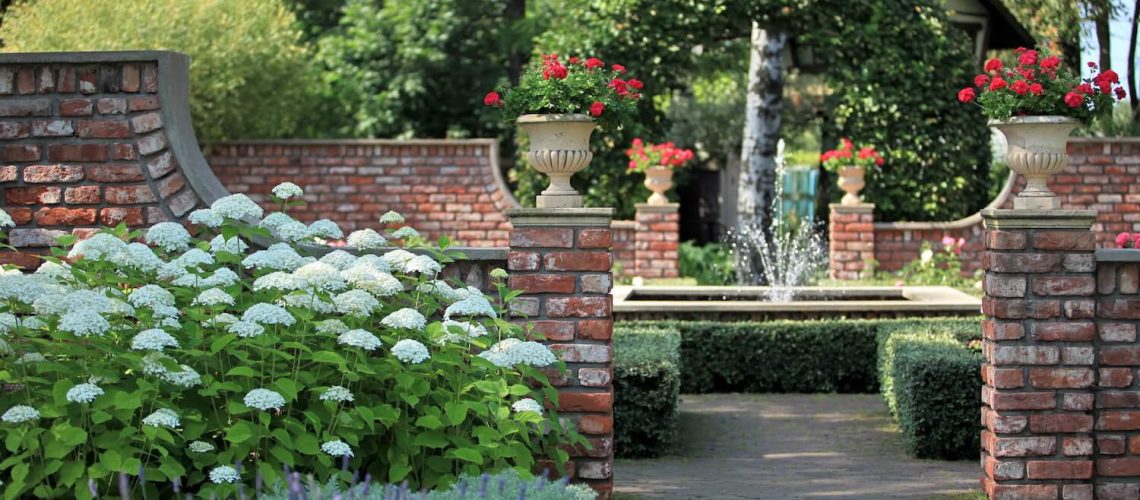A well-designed garden can be a source of immense joy and satisfaction. It’s a place of respite, a haven for relaxation, and an extension of your home’s living space. To elevate your garden to the next level, consider incorporating brick pavers into your garden design. Brick pavers offer a timeless, durable, and versatile option that can transform your garden into a work of art.
In this article, we’ll explore various ideas and tips for incorporating brick pavers into your garden design.
The Beauty of Brick Pavers
Brick pavers, also known as brick tiles or paving stones, have been a favored choice for garden design for centuries. Their timeless appeal lies in their classic and elegant appearance, which complements a wide range of architectural styles and garden themes. Brick pavers come in various colors, shapes, and sizes, allowing for endless creativity in garden design.
What makes brick pavers particularly appealing for garden design is their ability to seamlessly blend with both traditional and contemporary aesthetics. Whether you have a cottage-style garden, a minimalist modern garden, or anything in between, brick pavers can be adapted to suit your vision.
The Benefits of Brick Pavers in Gardens
Before diving into design ideas, let’s explore the advantages of using brick pavers in your garden:
1. Durability: Brick pavers are exceptionally durable and can withstand the wear and tear of foot traffic, making them a practical choice for garden pathways, patios, and other high-traffic areas.
2. Low Maintenance: Once installed, brick pavers require minimal maintenance. Routine sweeping and occasional power washing will keep them looking pristine.
3. Versatility: Brick pavers offer versatility in design. They come in various shapes and colors, making it easy to create patterns, borders, and unique garden features.
4. Eco-Friendly: Brick pavers are environmentally friendly as they are made from natural clay and require minimal processing. They are also recyclable and can be repurposed if needed.
5. Timeless Aesthetic: The classic look of brick pavers adds an enduring touch of sophistication to your garden, enhancing its overall charm and appeal.
Now, let’s explore how to incorporate brick pavers into your garden design with some creative ideas and practical tips.
Ideas for Incorporating Brick Pavers Into your Garden
Outdoor Garden Pathways
A well-designed garden pathway can make a significant difference in the overall look and functionality of your garden. Brick pavers are an ideal choice for creating garden pathways due to their durability and timeless aesthetic.
Tip: Choose a layout pattern for your pathways that complements the garden’s style. For a more formal look, consider a herringbone pattern, while a running bond pattern can give your garden a relaxed and informal feel.
Patios and Outdoor Seating Areas
Transform a section of your garden into an inviting outdoor seating area with the help of brick pavers. A brick paver patio is not only functional but also aesthetically pleasing, making it an excellent space for dining, entertaining, or simply unwinding amidst the beauty of your garden.
Tip: Enhance the comfort and style of your outdoor seating area with the addition of weather-resistant cushions and cozy outdoor furniture. Planters with colorful flowers and decorative lighting can further elevate the space.
Retaining Walls
Brick pavers can be used to create visually appealing and functional retaining walls. These walls can be used to define garden beds, prevent erosion, and add depth to your garden design.
Tip: When constructing retaining walls, consider the height and positioning carefully to create visual interest and enhance the overall structure of your garden.
Borders and Edging
Brick pavers make for excellent garden borders and edging. They can define garden beds, separate different sections of your garden, and help keep your garden organized and visually appealing.
Tip: Choose contrasting colors or shapes for your garden borders to create a visually striking effect. Make sure the height of the border complements the surrounding elements in your garden.
Garden Features
Elevate your garden’s charm by incorporating brick pavers into various garden features. Consider adding brick pavers to your garden by:
- Creating a mosaic: Arrange brick pavers to form intricate patterns or mosaic designs on the ground.
- Building a fountain base: Use brick pavers to construct a sturdy base for a garden fountain, enhancing its visual appeal.
- Designing a garden chessboard: Lay brick pavers in a chessboard pattern to create an outdoor chess or checkers board.
- Decorating garden sculptures: Place brick pavers around garden sculptures to create a focal point within your garden.
Tip: Garden features crafted with brick pavers should be integrated harmoniously with the overall garden design, ensuring they complement the landscape.
Outdoor Kitchen and Grill Area
If you enjoy outdoor cooking and entertaining, consider incorporating a brick paver outdoor kitchen or grill area into your garden. This addition can be a delightful space for preparing meals, dining, and socializing.
Tip: Ensure proper drainage and easy access to utilities like water and gas when designing your outdoor kitchen. Incorporate comfortable seating and ambient lighting to enhance the space’s functionality and ambiance.
Fire Pit
A brick paver fire pit is an excellent addition to any garden, providing a cozy spot for evening gatherings, roasting marshmallows, or simply enjoying a warm fire under the stars.
Tip: Consider adding built-in seating around the fire pit for a more intimate and inviting atmosphere. Ensure the design complements the garden’s overall look and feel.
Garden Steps and Stairs
If your garden has varying elevations, brick pavers can be used to create attractive and functional garden steps or stairs. These can provide easy access to different levels of your garden and add an architectural element to the landscape.
Tip: Ensure the steps are designed with safety in mind, providing proper footing and handrails where necessary. Choose a brick paver color and style that blends seamlessly with the garden’s surroundings.
Maintenance Tips for Brick Pavers in Gardens
To keep your brick pavers looking their best and ensure their longevity in your garden, here are some maintenance tips:
- Regular Cleaning: Sweeping your brick pavers regularly to remove debris and dirt will help prevent staining. Occasional power washing can maintain their appearance.
- Weed Control: Check the joints between the pavers for weed growth and remove any weeds as soon as they appear. Using polymeric sand in the joints can help prevent weed growth.
- Sealing: Applying a paver sealer can enhance the color of your brick pavers and protect them from staining and weathering. Reapply the sealer as needed, typically every few years.
- Repair Damaged Pavers: If you notice any cracked or damaged pavers, it’s essential to replace them promptly to prevent further issues.
Designing with Brick Pavers: Tips and Considerations
While using brick pavers in your garden design offers a multitude of creative opportunities, here are some essential tips and considerations:
- Choose the Right Pavers: Select brick pavers that complement the architectural style of your home and the overall theme of your garden. Consider the size, shape, and color of the pavers carefully.
- Plan for Drainage: Ensure proper drainage in areas where brick pavers are used to prevent water from pooling. Use gravel or sand as a base for pathways and other areas.
- Professional Installation: For complex projects or those requiring precise leveling and grading, consider hiring a professional to ensure a flawless installation.
- Maintenance: Keep up with regular maintenance to preserve the appearance and longevity of your brick pavers. This includes cleaning, weed control, and sealing as needed.
- Garden Safety: If you’re adding features like steps or stairs, prioritize safety by providing proper footing and handrails where necessary, especially in areas with elevated brick pavers.
- Plant Selection: When using brick pavers for planting pockets or raised beds, consider the plant species that will thrive in those areas. Ensure that they receive the right amount of sunlight and water.
Conclusion
In conclusion, incorporating brick pavers into your garden design offers a multitude of creative possibilities and practical benefits. Whether you’re creating garden pathways, patios, retaining walls, borders, or unique garden features, brick pavers bring enduring beauty and functionality to your outdoor space. By following these design ideas and maintenance tips, you can transform your garden into a stunning oasis that provides years of enjoyment and a welcoming retreat for all who visit. Brick pavers are a timeless choice that will continue to enrich your garden’s aesthetics and usability.

